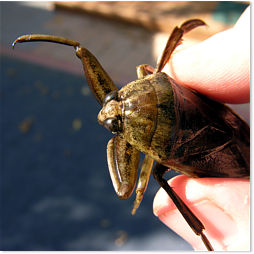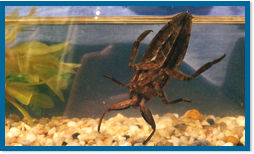
Toe-biter: The Giant Water Bug
 Be careful when you pick one up!
Be careful when you pick one up!by Doug Collicutt
A knock at the side door was an all too welcome excuse to push back from the keyboard in my basement office. From the foot of the stairs, I could see who it was through the aluminum door. "Hi, Rita," I said. It was a neighbour from across the street.
"Hi, Doug," she answered. "There's this huge insect, like a giant cockroach on the road. I thought you might want to see it." (That, of course, was something that Rita already knew. As the "critter guy" in the neighbourhood, she knew I'd want to investigate anything!)
"You bet," I said. "Is it still alive?" I asked as we headed down the sidewalk towards the front street.
"Yeah, it was crawling around," she replied. "It's really big." She pointed to the spot where she'd seen it, but the motion on the asphalt had already caught my eye. And my initial suspicions were confirmed.
"Oh, cool, it's a giant water bug!" I exclaimed as I broke into a trot, then stooped down and grabbed the creature before it could fly away or get run over. I held it up for Rita to see. "It's a nice big one. Wow, that's got to be over 5 cm long." She came a little closer for a better look.
|
"Ooh, weird . . . oh, I think I've seen those before," she said. And she probably had. Giant water bugs are quite common and it's not out of the ordinary for one to be crawling around on dry land. I explained to her that although this was an aquatic insect, it had wings and was a powerful flyer. They are frequently attracted to lights at night, hence another one of their common names: "electric light bug". In so doing they often become disoriented and it's not uncommon to find them in cities along roads or parking lots, having been drawn to street lights. Over the years, I've found many a giant water bug crawling along a stretch of concrete, or schmooshed on it. And I've only ever come across one live one in a pond. "So what are you going to do with it?" she asked.
"Turn it into a Summer Issue Bug Feature on NatureNorth!" I replied. And here it is.
Biology of Giant Water Bugs
The Giant Water Bug that had the good fortune to be rescued by me, rather than being left to get run over on the road turned out to be a specimen of Lethocerus americanus. This is probably the most common species of giant water bug found in Manitoba, although information about them is spotty. I wasn't able to track down exactly how many species we have, but there's likely at least two. Giant Water Bugs belong to the Family: Belostomatidae and fall within the Order: Hemiptera (the bugs), of the Class: Insecta (insects). There are perhaps 150 species of Giant Water Bugs worldwide with the largest being up to 150 mm long (6 inches)!
The habitat of Giant Water Bugs in Manitoba includes ponds, marshes, lakes and slow moving rivers and streams. Lethocerus americanus is widely distributed in North America, but as with many creatures, its exact range in this province isn't known. They are certainly found throughout most of the southern half of the province. If you northern Manitobans have any information on the subject, please let us know.
Adult Giant Water Bugs are most often encountered by people when they are out of their natural element, the water. Adults often fly around, perhaps searching for other water bodies to colonize or for mates. They fly mainly at night and it's thought that they use light sources (before humans this was the moon or stars) as beacons to orient their flight. With the advent of electric lights, Giant Water Bugs, and a lot of other insects, (moths for example) faced a hitherto unknown situation, light sources that were not at a fixed point in the sky. These light sources were close enough that they appear to move as the insect flies, unlike the distant moon or stars. The net result of trying to navigate using a point of light that you think should stay fixed, but which in fact isn't, tends to be flight that spirals in toward the light. Water bugs and other insects may not be "attracted" to lights as much as they are disoriented by them and once too near the light can't find any other beacon to navigate by. In the end they become exhausted from aimlessly flying around the light and end up lying on the ground below street lights on roads or parking lots.
In late spring or early summer the adult bugs mate and the female glues her eggs on the stems of emergent vegetation or other structures just above the water's surface. The male remains nearby to protect them and to keep them moist by periodically crawling out of the water and over top of the eggs. The young are called nymphs and hatch in about 2 weeks. The nymphs resemble the adults and go through 5 developmental stages, shedding their skin to move from one stage to the next. This is known as "simple" metamorphosis. In the "complete" metamorphosis of butterflies and other insects, larvae don't resemble the adults and there is a resting or pupal stage prior to emergence of the fully formed adult. Adult water bugs overwinter in water bodies. (I wasn't able to find out when the last moult from nymph to adult occurs in Manitoba. Does anybody out there know? If so, please drop us a line.)
As larvae, Giant Water Bugs obtain oxygen through their cuticle (skin), but the adults must breath air directly. They do this, and remain under water, by means of a snorkel-like appendage at the base of their abdomens. This tube allows for the exchange of air from the atmosphere to a bubble of air trapped under the wings. Air enters the insect's body through holes, called spiracles, in the abdomen.
Giant Water Bugs, and their nymphs, are fierce predators feeding on small fish, tadpoles, salamanders, even small frogs. They usually hunt by lying-in-ambush clutching a submerged plant or rock with only their breathing tube sticking above the surface. Any passing motion can trigger a rapid "lunge and grab" with the hook-tipped front legs. (My captive bug would even lunge and grab the net or anything else I stuck into the aquarium. I had been warned not to stick my fingers in front of its face and I willingly complied. ) If prey is successfully grasped it is quickly dispatched with a pierce from the bug's needle-like rostrum (fused mouth parts) and an injection of toxic enzymes. These enzymes poison the prey and begin to digest it at the same time. Once the enzymes have completed their job the bug again uses its rostrum, but this time sucks out the pre-digested soup that was its prey, leaving a limp bag of skin. If this critter sounds like some kind of mini-monster, don't despair. In the orient, giant water bugs are renowned as a great delicacy, so, as always, critters seem to have more to fear from us than we from them.
The bug's hunting technique is not limited to lying in wait. It will actively swim after prey that is a ways off or that it has missed on its first lunge. The hind legs are paddle-shaped and equipped with long hairs that fan out as the leg is stroked to increase its effective surface area. Giant water bugs can swim, or scull, through the water rapidly in search of prey or to evade becoming prey themselves.
Giant Water Bugs, ya gotta love'em! So, keep your eyes peeled in parking lots near water, but if you find a live one, pick it up carefully!
|
Thanks for learning about Giant Water Bugs! Bye for now!
Some other Bug Features in NatureNorth: Marvelous Monarchs | Mourning Cloak Butterflies
| You can help NatureNorth produce more great articles with a secure donation through PayPal. Our Google Adsense ads pay our server costs, but that's about it. To learn more follow this link: Support NatureNorth. Thank-you! | |
Return to: Summer Issue | NatureNorth Front page



